Research Article
The Effects of Portulaca Oleracea Alcoholic Extract on Induced Hypercholesterolemia in White Albino Rats
4026
Views & Citations3026
Likes & Shares
Background: Hypercholesterolemia is a major risk factor for cardiovascular diseases. Portulaca Oleracea is a vegetable, known in traditional medicine and has many medicinal properties. In the present study the effects of alcoholic extract of Portulaca Oleracea on blood cholesterol level was evaluated.
Materials and Methods: In this experimental study, 25 white albino rats in the weight range of 180-300 g in 5 groups (n=5) were selected as follows: Control group receiving normal diet, diseased control group receiving normal diet after increasing of the cholesterol level by high fat diet and cholesterol powder, experimental groups divided into three groups after increasing of the cholesterol level by high fat diet and cholesterol powder (leaves/stem mixture extract group receiving leaves/stem mixture extract of the Portulaca Oleracea, Seeds extract group receiving seeds extract of the Portulaca Oleracea and drug group receiving atorvastatin as reference drug). Fasting blood samples were collected weekly for 5 weeks.
Results: Concerning the stem/leave mixture extract, it was found that the Cholesterol level was depressed from 221 to 103 mg / dl during a period of five weeks, whereas the depression was from 210 to 99 mg / dl using a seed extract and from 229 to 105 mg / dl using a drug during the same period. If we compare these results with the normal depression of the disease control group, we conclude that seed extract produces the best results concerning depression the Cholesterol value (P ≤ 0.05).
Conclusion: The results of this study show that oral intake of alcoholic extract of Portulaca Oleracea can play an important role in reducing cholesterol levels, better or similar to the use of atorvastatin.
Keywords: Portulaca Oleracea, Cholesterol, Hypercholesterolemia
INTRODUCTION
Cholesterol
Cholesterol is the metabolic precursor of steroid hormones, substances that regulate a great variety of physiological functions including sexual development and carbohydrate metabolism. Cholesterol is a major component of animal plasma membranes, where it is typically present at 30 to 40 mol %, and occurs in lesser amounts in the membranes of their subcellular organelles. Its polar OH group gives it a weak amphiphilic character, whereas its fused ring system provides it with greater rigidity than other membrane lipids. Cholesterol is therefore an important determinant of membrane properties. It is also abundant in blood plasma lipoproteins, where 70% of it is esterified to long-chain fatty acids to form cholesteryl esters. Cholesteryl ester transfer protein (CETP) inhibition reduces vascular event risk [1].
Biomedical importance
Cholesterol is present in tissues and in plasma either free cholesterol or as a storage form, combined with a long-chain fatty acid as cholesteryl ester. In plasma, both forms are transported in lipoproteins. Cholesterol is synthesized in many tissues from acetyl-CoA and is the precursor of all other steroids in the body such as corticosteroids, sex hormones, bile acids, and vitamin D. A study in this special issue of Nutrients systematically reviewed the literature on the diurnal rhythms of cholesterol synthesis and absorption markers, and of bile acid synthesis markers [2].
Hypercholesterolemia (HC)
Hypercholesterolemia is characterized by coronary endothelial dysfunction, the hallmark of which is an altered vasodilatation to endothelial-dependent vasodilators. Most of heart diseases are associated with high cholesterol level [3].
Complication of high cholesterol on the body
Cholesterol moves through your bloodstream via lipoproteins. Low-density lipoproteins (LDL) and High-density lipoproteins (HDL). While cholesterol is central to many healthy cell functions, it also can have a harmful effect on the body if it is allowed to reach abnormal blood concentrations. Interestingly, when LDL-cholesterol levels are too high, the condition referred to as hypercholesterolemia, the risk for premature atherosclerotic cardiovascular diseases (ASCVD). Increases Risk factors of CVD are affected by nutrients, foods, dietary patterns, and energy balance. Four very interesting studies in this issue tried to address these aspects [4]. A study during Ramadan period for Muslim people proved that high fiber cereal at dawn (Sohor) on satiety affects bowel habits, body composition, blood glycemia, and blood lipidemia and it was found that this consumption had a positive effect on satiety, and it improved bowel functions and blood lipid levels [5]. Another important aspect in this cholesterol issue was the association between CVD and bone metabolism, a positive correlation between CVD and osteoporosis risk has been suggested, which implies a close relationship between hyperlipidemia and/or hypercholesterolemia and bone metabolism [6]. A very interesting review in this issue focused on the beneficial and harmful cholesterol actions in eye lens focusing especially on high cholesterol, which has a different function in the eye lens compared to other tissues and organs. It was emphasized that the major difference between cholesterol action in the lens versus in other tissues and organs is that the eye lens is a vascular, and therefore it is not exposed to blood and its related components, including cholesterol transported in LDL and HDL. Additionally, differentiation of lens fiber cells involves formation of an organelle-free zone comprising of cells devoid of these. Since the organelle-free zone in the lens consists of only the plasma membranes and cytosol, the high cholesterol content in the lens seems to be important and beneficial [7]. High cholesterol level can create a bile imbalance, leading to gallstones. These gallstones may go on further to develop complications such as cholecystitis, cholangitis, choledocholithiasis, gallstone pancreatitis, and rarely cholangiocarcinoma [8].
Classification of the plant
Kingdom : Plantae
Order : Caryophyllales
Family : Portulacaceae
Genus : Portulaca
Species : P.oleracea [5]
METHOD
Preparation of the ethanolic extraction
The stem &leaves of Portulaca Oleracea L. were crashed into coarse size, 150g was soaked in 1.5 l of 80% ethanol for three days. Extraction carried out till the color of the solvent in the last time become colorless. Solvent was evaporated under reduced pressure using rotary evaporated apparatus. Extract was allowed to air till complete dryness and the yield weight was calculated (Table 1).


The seeds of Portulaca Oleracea were crashed into coarse size; 700g was soaked in 7 l of 80% ethanol for three days. Extraction carried out till the color of the solvent in the last time become colorless. Solvent was evaporated under reduced pressure using rotary evaporated apparatus. Extract was allowed to air till complete dryness and the yield weight was calculated (Table 2).


Preparation of Portulaca Oleracea dose for two extracts
Based on General Formula (10ml/1kg) one dose Portulaca Oleracea. Extract was prepared and each rat received the suitable dose base on its weight.
The high dose (800 mg/kg) was prepared by dilution of 0.8g of the extract in 10 ml of distilled water [6].
Dose Volume (ml) =
Dose Volume (ml) =

Preparation of atorvastatin
Tablet of 20 mg was dissolved in 10 ml of distilled water. Based on general formula 10ml/1kg the doses calculated for each rat individually.
Primary check of cholesterol in the rats
Randomly fasting blood cholesterol level was done in 10 rats two from each group to identify the level of cholesterol before the administration of special diet that contain high saturated fat and cholesterol powder to elevate the level of cholesterol in albino rats.
Induction of the cholesterol enrich diet
For three weeks the rats were feed with cholesterol enrich diet and at the fourth week the rats receive mixture of cholesterol powder and cheese by feeding tube for three days and each rat receive the mixture according to weight. The mixture is composed of 9.9 g of cholesterol powder (99%) and 50 g cheese.
Sample collection
Fasting blood samples were collected from the retro-orbital plexus of the eye using heparinized capillary tube in lithium heparin blood container. The procedure was done under anesthesia using the chloroform. Samples was collected once every week for seven consecutive weeks.
- Pre sampling: before the administration of cholesterol enrich diet.
- Post sampling: after introducing cholesterol enrich diet and cholesterol powder.
- 1st Sampling: after one week from started the treatment.
- 2nd sampling: after two weeks from treatment.
- 3rd sampling: after three weeks from treatment.
- 4th sampling: after four weeks from treatment.
- 5th sampling: after five weeks from treatment.
The plasma was separated from blood sample by centrifugation at 3000 rpm for 15 minutes and the cholesterol level was measured immediately.
Determination of blood cholesterol level
Blood cholesterol level was determined by using Biosystem kits according to the leaflet which contains.
Principle of the reaction
Free and esterified cholesterol in the sample originates, by means of the coupled reactions described below, colored complex that can be measured by spectrophotometer.
Cholesterol ester + H2O chol.Esterase cholesterol + fatty acid.
Cholesterol + ½ O2 + H2O chol.Oxidasecholestenone + H2O2
2H2O2 + 4-Aminoantipyrine + phenol peroxidaseQuinoneimine + 4H2O
Reagent (A), samples and cholesterol standard brought into room temperature and pipetted into labelled test tubes (from 1to 6 for each group) as following (Table 3):
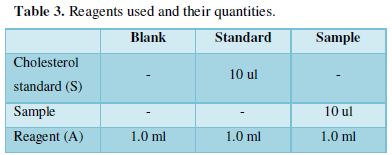

The mixtures were mixed and the test tubes were incubated for 10 min at room temperature. Then the absorbance of the samples and the standard were measured at weave length 500 nm after that the spectrophotometer was adjusted by using the blank.
The cholesterol concentration in the samples were calculated using the below general formula.
Concentration of cholesterol = 
* Concentration of the standard

* Concentration of the standard
Experiment protocol
The 5 group of hypercholesteremic rats were treated orally using feeding tube for 5 weeks as follows:
- Normal control group: this group was received normal food daily for 5 weeks.
- Steam &leaves mixture extract group: this group received Portulaca Oleracea (stems& leaves mixture extract) for 5 weeks.
- Seeds group: this group was received Portulaca Oleracea (seeds extract) for 5 weeks.
- Reference drug group: this group was received atorvastatin (20mg) for 5 weeks.
- Disease control group: this group was received normal food for 5 weeks.
RESULTS (TABLES 4-8 & FIGURES 1-5)

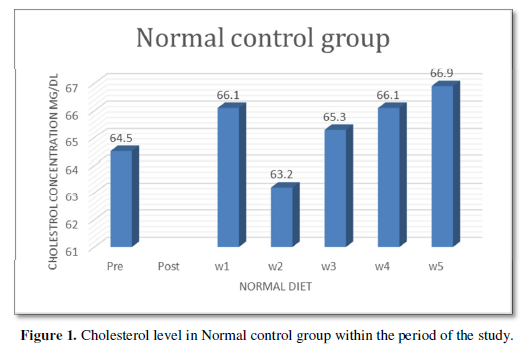
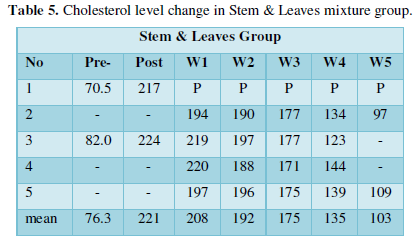
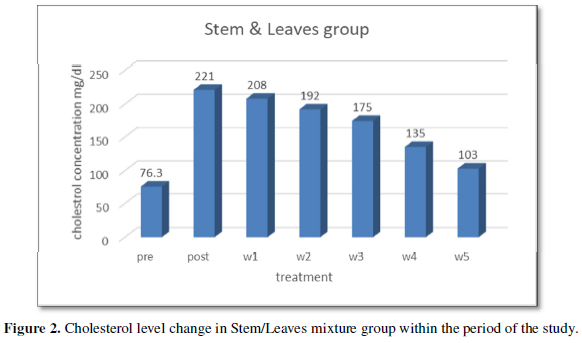

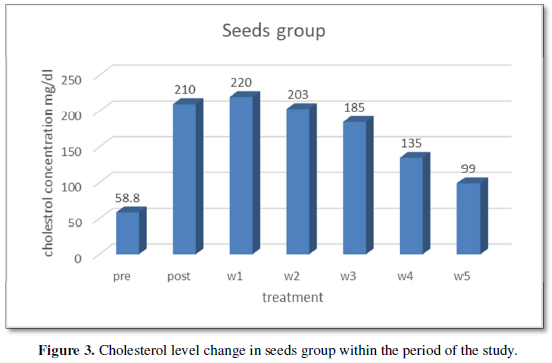
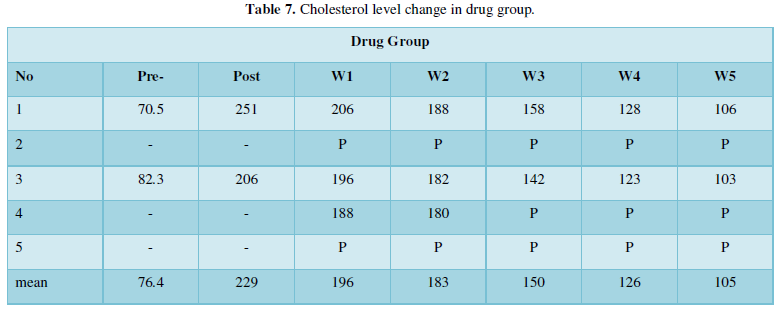
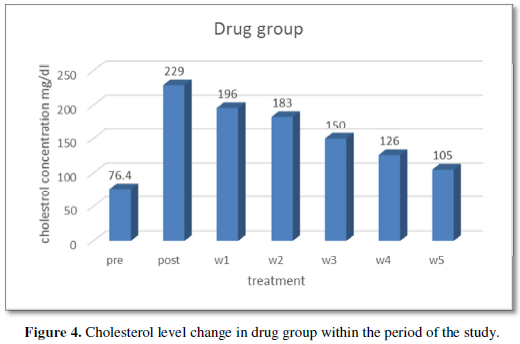

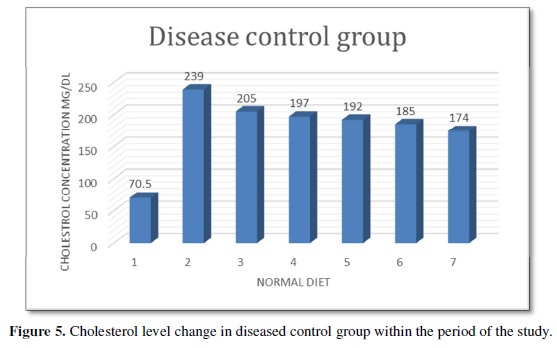










DISCUSSION
The main aim of this work is to study the changes accompanied depression of the cholesterol level using Portulaca Oleracea alcoholic extract. A cholesterol molecule is a lipid, which is a category of water-insoluble substances such as waxes, oils and fats. High cholesterol leads to hardened arteries, coronary heart disease and even strokes. Because it can't dissolve in water, cholesterol can't move around in the bloodstream on its own. In order to travel around the body, cholesterol combines with protein, forming a lipoprotein (lipid + protein). The protein actually coats the cholesterol. However, not all lipoproteins are created equal. In high-density lipoprotein (HDL), when the lipoprotein has more protein than cholesterol, the cholesterol arrives quickly at the liver, where it's converted into bile acids. They are called ‘good’ cholesterol. Whereas low density lipoprotein (LDL) is called “bad cholesterol”.
The liver uses saturated fat to make cholesterol, so eating foods with too much saturated fat can increase cholesterol levels, especially low-density lipoproteins (LDL)-the bad cholesterol. Saturated fats are usually found in animal products such as whole milk, cream, butter, and cheese, and meats, such as beef, lamb and pork. There are some plant-based saturated fats you should avoid too, notably palm kernel oil and coconut oil.
Calculating the cholesterol ratio can provide useful information about your heart disease risk cholesterol ratio is calculated by dividing the high-density lipoprotein (HDL, or ‘good’) cholesterol into the total cholesterol. For example, if the total cholesterol is 200 milligrams per deciliter (mg/dL) (5.2 mill moles per liter, or mmol/L) the HDL cholesterol is 50 mg/dL (1.3 mmol/L), the cholesterol ratio is 4-to-1. According to the American Heart Association, the goal is to keep your cholesterol ratio 5-to-1 or lower. An optimum ratio is 3.5-to-1. A higher ratio indicates a higher risk of heart disease; a lower ratio indicates a lower risk.
For treatment purposes, it's important to know absolute numbers for all of the cholesterol levels. People with very low HDL levels or very high LDL levels may be at substantial risk. There are effective ways to lower LDL cholesterol that are proven to reduce risk.
Cholesterol depression value (Hypercholesterolemia) was traced in white Albino Rats when subjected to an alcoholic extract of Portulaca Oleracea. Extraction was carried out from two parts of the plant, those are, the seeds as part1 and the stem/leaves mixture as part 2. Hypercholesterolemia was also traced using drug (atorvastatin).
Concerning the stem/leave mixture extract, it was found that the Cholesterol level was depressed from 221 to 103 mg / dl during a period of five weeks (Figure 2), whereas the depression was from 210 to 99 mg / dl using a seed extract (Figure 3) and from 229 to 105 mg / dl using a drug (Figure 4) during the same period. If we compare these results with the normal depression of the disease control group (Figure 5) we conclude that seed extract produces the best results concerning depression the Cholesterol value.
We consider this work to be a pioneer in a sequence of subsequent project works trying to synthesize naturally occurring treatment in order to find simple path way to cure the so called “vital heart problems” also if any individual suffering of heart problem or other any complications due to the hypercholesterolemia regularly take this plant in his food this will a very good habit for protection from hypertension and cardiac complications due to hypercholesterolemia especially this plant is normally taken as traditional Sudanese foods [9-12].
CONCLUSION
The results of this study show that oral intake of alcoholic extract of Portulaca Oleracea can play an important role in reducing cholesterol levels. This performance is probably more related to the high density of antioxidants and omega-3 found in this herb and reduction of the cholesterol synthesis mechanisms.
- Kettunen J, Holmes MV, Allara E, Anufrieva O, Ohukainen P, et al. (2020) Correction: Lipoprotein signatures of cholesteryl ester transfer protein and HMG-CoA reeducates inhibition. PLoS Biol 18(3): e3000694.
- Schroor MM, Sennels HP, Fahrenkrug J, Jorgensen HL, Plat J, et al. (2019) Diurnal Variation of Markers for Cholesterol Synthesis, Cholesterol Absorption, and Bile Acid Synthesis: A Systematic Review and the Bispebjerg Study of Diurnal Variations. 11: 1439.
- Ibrahim MA, Asuka E, Jialal I (2021) Hypercholesterolemia. In: StatPearls [Internet]. Treasure Island (FL): StatPearls Publishing; 2021 Jan.
- Bardagjy A, Steinberg F (2019) Relationship between HDL Functional Characteristics and Cardiovascular Health and Potential Impact of Dietary Patterns: A Narrative Review. Nutrients11: 1231.
- Jarrar A, Beasley J, Ohuma E, Ismail CL, Qeshta D, et al. (2019) Effect of High Fiber Cereal Intake on Satiety and Gastrointestinal Symptoms during Ramadan. Nutrients 11: 939.
- Yin W, Li Z, Zhang W (2019) Modulation of Bone and Marrow Niche by Cholesterol. Nutrients 11: 1394.
- Widomska J, Subczynski W (2019) Why Is Very High Cholesterol Content Beneficial for the Eye Lens but Negative for Other Organs? Nutrients 11: 1083.
- Kurzweil A, Martin J (2020) Transabdominal Ultrasound. In: StatPearls [Internet]. Treasure Island (FL): StatPearls Publishing.
- Mason W (2005) Understanding Cholesterol.
- Evans WC (2002) Aspect of Asian medicine and it’s practice in the westpharmacognacy. 15: 478.
- Li F, Li Q, Gao D, Peng Y, Feng C (2009) Preparation and antidiabetic activity of polysaccharide from Portulaca Oleracea Afr J Biotechnol 8(4): 569-573.
- Londonkar (2011) Phytochemical and Antimicrobial Activities of Portulaca Oleracea J Pharm Res 4(10): 3553.
QUICK LINKS
- SUBMIT MANUSCRIPT
- RECOMMEND THE JOURNAL
-
SUBSCRIBE FOR ALERTS
RELATED JOURNALS
- Journal of Genetics and Cell Biology (ISSN:2639-3360)
- Journal of Womens Health and Safety Research (ISSN:2577-1388)
- Journal of Genomic Medicine and Pharmacogenomics (ISSN:2474-4670)
- Journal of Biochemistry and Molecular Medicine (ISSN:2641-6948)
- Food and Nutrition-Current Research (ISSN:2638-1095)
- Journal of Agriculture and Forest Meteorology Research (ISSN:2642-0449)
- Journal of Veterinary and Marine Sciences (ISSN: 2689-7830)







